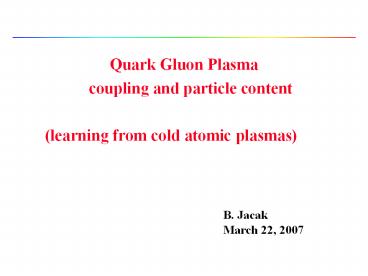Quark Gluon Plasma PowerPoint PPT Presentation
1 / 22
Title: Quark Gluon Plasma
1
- Quark Gluon Plasma
- coupling and particle content
- (learning from cold atomic plasmas)
B. Jacak March 22, 2007
2
stolen from Thomas Pohl
3
What is going on at RHIC?
- The objects colliding inside the plasma are
clearly not baryons and mesons - They are also not quarks and gluons totally free
of the influence of their neighbors - Are there even objects colliding in there?
- Is it, in fact, strongly coupled?
hydrodynamic flow implies that there are but q,g
number is not conserved (baryon number is)
ltPEgt/ltKEgt of WHAT?
4
What we DO know
PRL87, 052301 (2001)
Colliding system expands
- e ? 5.5 GeV/fm3 (200 GeV AuAu)
value is lower limit longitudinal expansion
rate, formation time overestimated
5
energy loss by induced gluon radiation
I. Vitev
dAu
interaction of radiated gluons with gluons
in the plasma greatly enhances the amount of
radiation
AuAu
calculate using opacity expansion (answer L/mfp
3.5) ? r 1000 gluons/dy e 15
GeV/fm3 hydro initial condition constrained by
data also requires e 15 GeV/fm3
6
Plasma Coulomb coupling parameter G
- ratio of mean potential energy to mean kinetic
energy - a interparticle distance
- e charge
- T temperature
- typically a small number in a normal, fully
shielded plasma - G 1/(number particles in Debye sphere)
- when G gt 1 have a strongly coupled, or non-Debye
plasma - many-body spatial correlations exist
- behave like liquids, or even crystals when G gt
150 - lD lt a
Ge (e2/4pe0 a)/kBTe
7
Debye screening in QCD a tricky concept
- in leading order QCD (O. Philipsen,
hep-ph/0010327) - vv
8
give up on the concept?
- Of course not!!!
- Two options proposed by Philipsen
- 1) assume a pole in the propagator and attempt to
measure its value from the exponential fall-off
in some fixed gauge (done with lattice QCD) - 2) seek a manifestly gauge invariant definition
- idea determine lD for strongly coupled plasma
convert e inside to particle density to get G
9
lets get a feel by oversimplifying
- estimate G ltPEgt/ltKEgt
- using QCD coupling strength g
- gluon density (? T3)
- ltPEgtg2/d d 1/(41/3T)
- ltKEgt 3T
- G g2 (41/3T) / 3T
- g2 4-6 (value runs with T)
- for T200 MeV plasma parameter G 3
- quark gluon plasma should be a strongly coupled
plasma - As in warm, dense plasma at lower (but still
high) T - dusty plasmas, cold atom systems
- such EM plasmas are known to behave as liquids!
G gt 1 strongly coupled, few particles inside
Debye radius
see M. Thoma, J.Phys. G31(2005)L7
10
2nd try take screening length from lattice QCD
Karsch, et al.
running coupling
coupling drops off for r gt 0.3 fm
11
use to estimate Coupling parameter, G
- G ltPEgt/ltKEgt but also G 1/ND
- for lD 0.3fm and e 15 GeV/fm3
- VD 4/3 p lD3 0.113 fm3
- ED 1.7 GeV
- energy of thermal, magnetic excitations gT, g2T
- to convert to number of particles, use gT or g2T
- for T 2Tc and g2 4
- get ND 1.2 2.5 ? G 1
- NB for G 1
- plasma is NOT fully screened its strongly
coupled! - affects interaction s!
- other strongly coupled plasmas behave as liquids,
even crystals for G 150 - dusty plasmas, cold atomsions , warm dense
matter
12
generally a phenomenon in crystals but not liquids
13
measuring viscosity in dusty plasma
melt crystal with laser light induce a shear flow
(laminar) image the dust to get velocity study
spatial profiles vx(y) moments, fluctuations ?
T(x,y) curvature of velocity profile ? drag
forces viscous transport of drag in ?
direction from laser compare to viscous hydro.
extract h/r shear viscosity/mass density PE
vs. KE competition governs coupling phase of
matter
14
minimum h at phase boundary?
strongly coupled dusty plasma
B. Liu and J. Goree, cond-mat/0502009
quark gluon plasma
Csernai, Kapusta McLerran nucl-th/0604032
minimum arises because kinetic part of h
decreases with G potential part increases
(measure by density-density correlation)
15
a minimum is characteristic
16
screening length bound state spectroscopy
17
summary
- its probably too soon to draw conclusions
- quark gluon plasma features
- fluid behavior
- opacity
- large drag on heavy quarks
- look like other strongly coupled plasmas
- color screening in QGP is not complete
18
- backup slides
19
from S. Ichimaru
20
expect low viscosity in strongly coupled plasma
S. Ichimaru, Univ. of Tokyo
21
why is correlation among particles interesting?
S(p) 1/N ltr(p)r(-p)gt r(p) is Fourier
transformed particle density r(r)
plasma physicists hope to measure by Thomson
scattering ? small angle scattering of soft g
from e charges coherent scattering off the
electrons is there an analogous measurement for
us?
22
screening masses from gluon propagator
- Screening mass, mD, defines inverse length scale
- Inside this distance, an equilibrated plasma is
sensitive to insertion of a static source - Outside its not.
Nakamura, Saito Sakai, hep-lat/0311024
T dependence of electric magnetic screening
masses Quenched lattice study of gluon
propagator figure shows mD,m 3Tc, mD,e
6Tc at 2Tc lD 0.4 0.2 fm
magnetic screening mass is non-zero not very
gauge-dependent, but DOES grow w/ lattice size
(long range is important)

